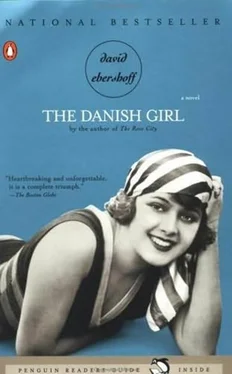But at least the rains had ended, and Pasadena was green, with its winter rye lawns like blankets of felt, its beds of snapdragons springing forth with pink and white blossoms, the Iceland poppies floating above the soil. In the orange groves, the white blossoms were like jackets of snow. To Greta, the roots of the orange trees looked like elbows pushing through the damp soil; they were the dull color of flesh, and just as thick as a man’s arm. The rains had softened the ground for the earthworms, which, in their blue-gray skins, reminded Greta of baby Carlisle’s birth matter. She’d never forget the wormlike color of the cord, twisted like a corkscrew. Nor the bluish mucus sealing the baby’s eyes, or the sheen of her own fluids covering him, as if he were encased in a thin, greasy sheet of protection, one her own body, in its independent wisdom, had designed.
She thought of this that spring when she was managing the orange groves in her father’s absence. She’d survey the land in the car with the flip-down windshield that carried her through the mud. She was supervising the crews, mostly teenage boys from Tecate and Tucson, hired to pick the understock. Beneath a tree whose fruit was falling prematurely, she saw a nest of worms slide through a clod of dirt. And this, now, made Greta think of Teddy and his cough. For nearly a year the sputum had hurled from his lungs, and at night he would soak the sheets in a sweat so icy that at first Greta had thought he’d spilled a glass of water into their bed. At the sound of the first cough, which had crept ominously up his throat like a ball of broken glass, she had suggested a doctor. He would cough and she would lift the telephone receiver to call Dr. Richardson, an egg-shaped man originally from North Carolina. But Teddy would argue, “There’s nothing wrong with me. I’m not going to see any doctor.”
Greta would return the receiver to its cradle and say only, “All right.” She’d have to wait until he was out of the house to make the phone call. Whenever he coughed and brought his handkerchief-which she herself had taken to pressing with a black iron-to his mouth, Greta would glance out of the corner of her eye to see if anything had come up with the cough. Sometimes it was dry, and she would silently sigh. But other times the cough would be phlegmy and a sluggy whitish fluid would swing from Teddy’s mouth to his handkerchief. And then, more and more, he would hack up a thick clot of blood. Because Greta, and not Akiko, would rinse all of Teddy’s laundry, including his handkerchiefs, she would see just how much blood he was coughing up. She would have to change the sheets nightly, and dip the handkerchiefs, and sometimes his shirts, into tubs of bleach, the bitter chlorine smell rising to her nostrils and stinging her eyes. The blood didn’t come out easily, and she would rub her fingertips raw trying to rid the handkerchiefs of their stains, which reminded Greta of the dropcloths she used around her easels back when she was painting, which now, settled in the casita in Pasadena, she wasn’t doing at all. But still, whenever Greta lifted the receiver, Teddy would say, “I’m not going to see any doctor, because I’m not sick, for chrissakes.”
A couple of times she managed to summon Dr. Richardson to the casita. Teddy would greet him in the sun room, his hair falling into his eyes. “You know how a wife can be,” Teddy would say. “Always worrying over nothing. But honestly, Doc, there’s nothing wrong with me.”
“Then what about your cough?” Greta would interrupt.
“Nothing more than a farmer’s hack. If you grew up in the fields you’d be coughing too,” he’d say, smiling, laughing, causing Dr. Richardson and Greta both to laugh as well, even though Greta saw nothing funny in what Teddy was doing.
“It’s probably nothing,” Richardson would say. “But do you mind if I take a look?”
“As a matter of fact I would.” The sun room had a floor paved with tiles Teddy had cast at his studio. They were the orange color of amber and laid with a black grout. In the winter, the tiles were too cold to stand on even in socks.
“Then call me if it gets any worse,” Dr. Richardson would say, clasping his bag in retreat.
And Greta, who more than anything else wanted to be a good wife, who didn’t want her husband to snicker with his buddies over how possessive and sneaky and shrill she’d become, would push her hair back over her ears and say, “All right then. If you’re not going to see Richardson, you’d better damn well take good care of yourself.”
The reason she considered this spring, the spring of 1918, greener than any other she could recall was that Teddy’s room in the sanitarium, where he was now settled, had a view of both the Arroyo Seco and the San Gabriel Mountains; she would sit in the chair at the window and study the green while Teddy slept. The sanitarium was a tan stucco building with a bell tower that hung on the lip of a cliff over the arroyo. There was a path around the property that was lined with rosebushes. The rooms were diamond-shaped and had hand-crank windows with views both north and south. Teddy’s bed was white iron, and every morning a nurse would come and get him into his rocking chair and then roll up the blue-striped mattress, where it would sit on the open springs at the foot of the bed like a huge roll of taffy.
Teddy had been in the sanitarium most of the winter, and rather than improving, he seemed only to worsen with each week. His cheeks were hollow, and his eyes clogged with something that looked like spoiled milk. Greta would arrive in the morning and immediately dab his eyes clean with the corner of her skirt. Then she would comb his hair, which had thinned to nothing more than a few colorless strands. On some mornings, his fever would be running so high that his forehead would be wet, and yet he was too weak to lift his own arm to wipe his brow. More than once she’d arrive and find him in his rocking chair like this: at the hand-crank window, in the sunlight, burning up from the fever and the flannel bathrobe that the nurse had tied around his hollow waist. From the way his face was twisted up, Greta could see he was trying to lift his arm to drag the flannel sleeve across his forehead; the sweat was dripping from his chin as if he’d been caught in a downpour. But this was March, and the winter rains were over, and all of Pasadena was jade green; instead of the clear blank sunlight burning the tuberculosis out of his lungs and his marrow, it was only setting Teddy on fire, so that before ten o’clock and the first arrival of his twice-a-day glass of kumquat juice, Teddy would have fainted beneath the weight of his fever.
By April, Teddy was sleeping more and more. Greta would sit in the rocker, the white padding on its arms worn threadbare, while he lay in bed on his side. Sometimes he would shift in his sleep, and the springs would creak, and it would sound to Greta like a groan from his bones, which were filled with tuberculosis, like an eclair stuffed with cream. His doctor, a man named Hightower, would come to the room, his white coat open over a cheap brown suit. Teddy continued to refuse treatment from Dr. Richardson, who treated not only every Waud in Pasadena but also the families of Henrietta and Margaret and Dottie Anne. “Dr. Hightower is fine for me,” he’d say. “I don’t need a fancy person’s doctor.”
“What the hell is ‘a fancy person’s doctor’ anyway?” Greta would say, regretting her raised voice the moment it escaped her throat. She didn’t want to contradict him; more than anything she didn’t want to hurt Teddy by saying she knew more than he. That was how she felt about it, and so she politely tolerated Dr. Hightower during his daily visits. The doctor was always in a rush, and he often did not have the proper paperwork in the manila file shoved up under his arm. He was a lanky man, with Norwegian-blond hair, like very light coffee. A transplant from Chicago, and there was something about the tips of his extremities-his nose, his ears, his nubby fingers-that looked frostbitten.
Читать дальше












